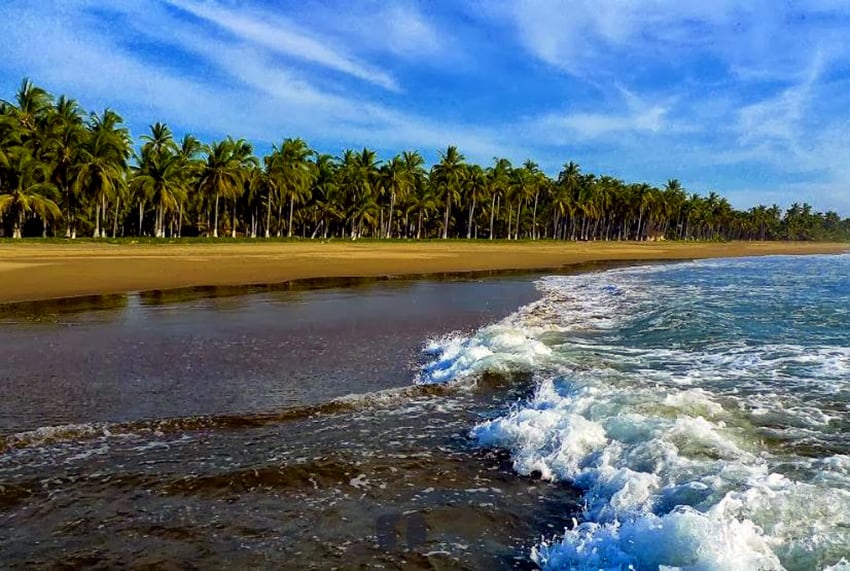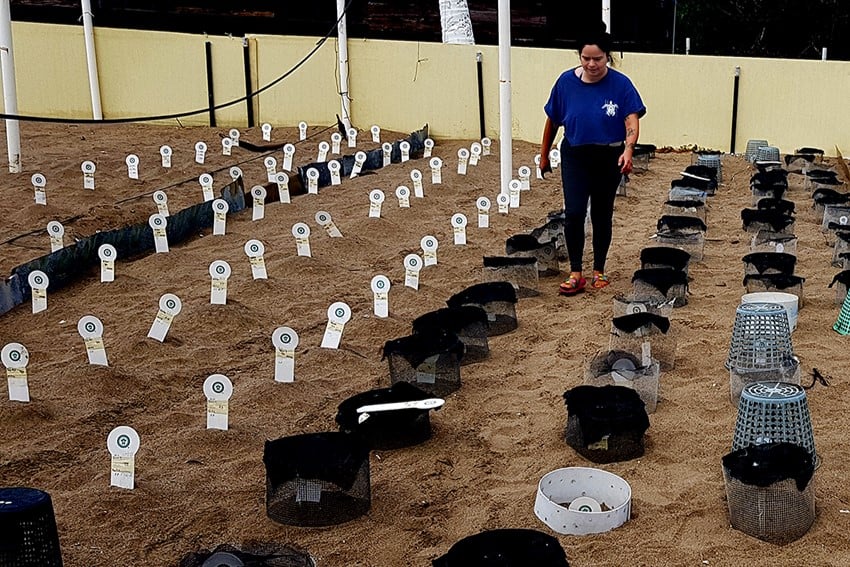For an up-close-and-personal sea turtle experience — just you, the turtles and a few biologists — you can’t beat the aptly-named Playa de las Tortugas, located 21 kilometers south of San Blas, in the state of Nayarit. On top of that, driving time to this little-known beach is only four hours and one minute from Guadalajara — two minutes on a bad day.
This sandy beach can only be reached by driving through an elegant compound called Playa de las Tortugas Villas, where you can rent a mansion or stay at a five-star hotel.

But if you’re in the mood for roughing it, you can wind your way through this development all the way to the beach, which is quite rustic and covered with coconut palms. It also features good waves for surfing and an estuary with long mangrove tunnels, perfect for kayaking.
After setting up my tent under a low coconut palm, I took a dip in the ocean, whose waters in mid-December were neither hot nor cold, but the perfect temperature for swimming.
After that, I wandered south along the beach and came to a big sign reading “WHAT DO I DO IF I SEE A TURTLE COME OUT OF THE OCEAN?”
The basic message was: keep back and don’t interfere. Just beyond the sign was an open gate and beyond the gate a handsome tower with a palapa on top of it.
A turtle egg garden

Soon, I came upon a sign welcoming me to Campamento Platanitos Center for the Protection and Conservation of the Sea Turtle. I was now inside a clean, pleasant-looking compound with numerous buildings and two fenced-off areas that appeared to be gardens — until I looked carefully.
Neat rows of little signs described not vegetables, but clutches of turtle eggs buried there: date of arrival, number of eggs, etc. And then in the “garden,” I found not a farmer, but a biologist. This was Ruth Ramírez, who had studied biology at the University of Guadalajara.
“What did your garden produce today?” I asked her. Her eyes lit up. “Come follow me,” she said, walking over to a small museum.
100 baby turtles trying to escape
Here, on the floor in the middle of the room, was a sort of giant plastic bathtub and inside it were at least 100 hopelessly cute little turtles, their shells only about 1 inch in diameter. Ninety percent of them were making little scuffling noises as they tried to climb the walls of the bathtub. The other ten percent weren’t moving.

“Are they dead?” I asked. “No,” Ramírez said, “just resting. In a minute they’ll be back at it, trying to reach the ocean.”
“How many days have they been in this tub?” I asked.
“What? All of these were born today and tonight we’re going to release them!” Ramírez explained to me that the job of the camp’s staff is to patrol the beach every night, collecting the turtle eggs that have been laid here and bringing them to the incubation corrals.
Threatened by extinction
“Typically,” the biologist said, “one of these turtles could produce between 60 and 180 eggs. Ramírez is referring to the olive ridley sea turtle, which is the turtle that most often comes up on these beaches in Nayarit.”

Ramírez explained to me that there are seven species of sea turtles in the world. One is endemic to Australia and all the others can be found in the Americas. And, she added, “All those other six species are officially listed as threatened by extinction globally.”
Ramírez led me to a display all about the olive ridley turtle. “They eat algae, sea grass, crabs and snails and when they are eight or ten years old, with a shell measuring some 70 centimeters in width, they return to the same beach where they were born to lay their eggs. Only the females come on to land, not the males.”
Ramírez says the high season for olive ridleys at Playa de las Tortugas is from May to August, “When the whole beach is full of turtles.” Now, in the winter, only one or two show up every night to lay their eggs.
The amazing belly-button recorder
In front of a model of a turtle nest, Ramírez explained that when a mother turtle arrives on the beach, she hunts for just the right place to lay her eggs, depending on information from a kind of sensor organ on the flat bottom of her shell. Then, with her back legs, she digs a tube-like hole and lays her eggs inside.

Incubation time varies by species. For the olive ridley sea turtle, it is 45 days from when the eggs are laid until they are hatched. At this moment, we were interrupted by visitors who, like me, were enchanted by the tubful of tiny turtles.“Can we pick them up?” they asked.
“Yes,” replied the biologist, “but be very careful not to touch the underside of their shell, called the plastron. Right in the middle of it, they have a belly button: what remains of their umbilical cord. This could provide them with nutrition for as long as ten days, keeping them alive as they enter the ocean.” Amazingly, this also acts as a highly sophisticated sensor recording all kinds of information as the baby turtle runs from its nest to the sea, sufficient information to enable it to return to the very same beach eight years later to lay its own eggs.
Bienvenidos, visitors and volunteers
The camp’s staff of four liberate turtles every evening at 5 p.m., making sure that predators such as raccoons, skunks, crabs and birds have no chance to end their run. Visitors who want to help with this are welcome to, and the same goes for the nightly beach patrols.
In spite of all their efforts, laments Ramírez, “the odds are against these little creatures. Only one in a thousand will live to return to our beach eight years from now.”
To see it all for yourself, pack up your tent, coconut machete and kayak and ask Google Maps to take you to Platanitos Turtle Camp, Nayarit.
The writer has lived near Guadalajara, Jalisco, for more than 30 years and is the author of A Guide to West Mexico’s Guachimontones and Surrounding Area and co-author of Outdoors in Western Mexico. More of his writing can be found on his website.
